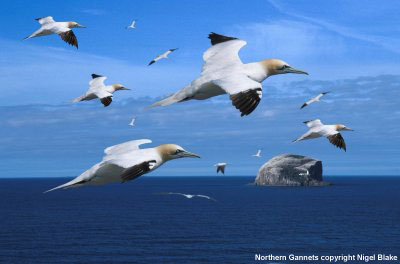
The art of digital birding
Nigel Blake's digital photography will be well known to regular visitors to surfbirds - remember those owls (click here if not !). Nigel is currently working on visual effects for the new Harry Potter movie, having previously worked on such greats as Goldeneye. Who could be better qualified therefore to explore the frontiers of digital birding. Having worked with digital composite pictures for many years, Nigel understands the need to match details such as lighting and atmospherics and of course scale and perspective ....but apply these techniques to digital bird imaging and a whole new field of bird photography (dare we use that word ?) appears on the horizon.
Nigel and the surfbirds team are well aware that digital images are turning the traditional world of bird photography on its head, so we have designed this feature to include its own discussion forum. Read about Nigel's work and then post your comments to the digital birding board.
Nigel has commented on his work as follows:
"Computers are now becoming an important tool for birders, e-mailing information, rare bird news, ID debates, web-rings, all serving to enhance our enjoyment of birding. All of these technologies help us both to find species that we might not otherwise see and to find those special locations on foreign birding trips. Yet the one area that seems to be taboo is digital manipulation of wildlife images, yet before computers studio shots were frequently used to create contrived images. Many TV documentaries use digital compilation to show aspects of the story that are difficult to film, the BBC's "Walking with Dinosaurs" being the current pinnacle of this technique. Is the creation of digital images with that sort of "wow" factor so different ?
With the aid of programmes such as Photoshop and Paintshop pro, it is possible to make images that show behaviour and life-style of a creature with less disturbance to the subject than might occur if photographed conventionally."
Below are two Dotterel pictures by Nigel (roll your cursor over the image and try to spot the differences in the re-worked image).

"The main image is the original photo, a grab shot from the car, taken near Tan Hill, North Yorkshire on a pretty dull day. I was too close with too long a lens resulting in the wing tip being cut off - not a shot for the bin, but nearly. After scanning, the image has been repaired (the roll-over image) by extending the frame size upwards and sampling bits of the other primaries which were then pasted in to create the missing wing tip. The background was cloned upwards also and then the colour was corrected to sunny daylight."
If you want to study Nigel's images in greater detail then here they are, separated below.


Congratulations to Nigel for his achievements - we agree with Nigel that this work is highly skillful, artistic and not in any way a de-skilling of bird photography, as some might argue. But what do you think ? What does this mean for committees accepting digital images as evidence of a rarity's presence - how far can a picture be manipulated before crossing the fine line of recording an event and passing into the world of bird art ?
For more of Nigel's work, visit his website at: http://www.nigelblake.co.uk
